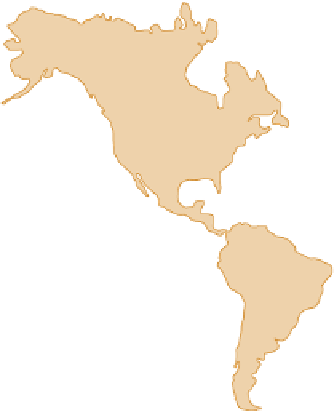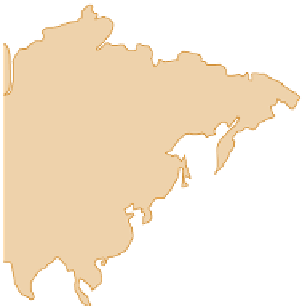Geoscience Reference
In-Depth Information
90
°
E
120
°
E
150
°
E
180
°
150
°
W
120
°
W
90
°
W
60
°
W
30
°
W
0
°
30
°
E
60
°
E
Asia
Skocjanske Jame
60
°
N
60
°
N
Ease Gill
Caverns
North America
Europe
Montespan
Mammoth Cave
Carlsbad
Cavern
Lascaux
Cave
30
°
N
30
°
N
Windsor Caves
Eisriesenwelt
Guangxi province
Atlantic Ocean
Pacific Ocean
Africa
San Agustin
Gunung Mulu
0
°
0
°
South America
Indian Ocean
Gruta do
Janelao
Australia
30
°
S
30
°
S
Indian Ocean
Cango Caves
Koonalda Caves
Jenolan Caves
150
°
W
120
°
W
90
°
W
60
°
W
30
°
W
0
°
30
°
E
60
°
E
Major limestone regions
Major karst regions
Figure 15.10 Location of major limestone and karst regions on Earth.
Large areas of limestone and karst occur on every
continent.
These paintings, as well as burials deep within the caves, have
given archaeologists important clues about the way people lived
and the animals that they hunted. Today, a lot of people like to
explore caves for the fun and challenge of it. Such cave enthu-
siasts are called
spelunkers
.
Caves and caverns form due to the complex interaction of
climate, groundwater, and local streams over time. Figure 15.11
illustrates the evolution of these landscapes. Cave formation
begins during a time (stage 1) when the water table is high
because the stream has not yet downcut a deep valley by ero-
sion. This concept of downcutting will be discussed in more
detail in Chapter 16, but for now, suffice it to say that one of the
things that streams do as they evolve is carve out deep valleys.
In the context of karst topography, the important relationship is
that the water table mirrors the behavior of the stream because
groundwater flows to the lowest point on the landscape—in
other words, the river channel.
Water flows horizontally
through limestone toward stream
Stream
Water table
Stage 1
Water enlarges
vertical joints
River valley deepens
Lower water
table
Water carves out
horizontal channel
Stage 2
Still lower
water table
Increased river erosion
causes major drop in water table
Figure 15.11 Cave and cavern evolution.
In Stage 1, lime-
stone below the water table dissolves, forming submerged cav-
erns. As the stream downcuts in Stage 2, the water table drops
in response, causing water to carve out channels in the limestone
as the water flows to the river. In Stage 3, the water table drops
farther, enough so that the formerly submerged caverns are now
located in the unsaturated zone. Surface water percolates into
these open features, resulting in the formation of stalagmites and
stalactites.
Sinkholes
Caverns now empty
New horizontal channel
Stage 3































































































































































































































































































































